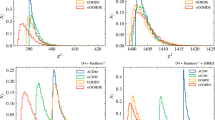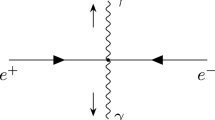Abstract
From the equivalence principle, one gets the strength of the gravitational effect of a mass M on the metric at position r from it. It is proportional to the dimensionless parameter β 2=2GM/rc 2, which normally is ≪1. Here G is the gravitational constant, M the mass of the gravitating body, r the position of the metric from the gravitating body and c the speed of light. The seeable universe is the sphere, with center at the observer, having a size such that it shall contain all light emitted within it. For this to occur one can impose that the gravitational effect on the velocity of light at r is zero for the radial component, and non zero for the tangential one. Light is then trapped. The condition is given by the equality R g =2GM/c 2, where R g represents the radius of the seeable universe. It is the gravitational radius of the mass M. The result has been presented elsewhere as the condition for the universe to be treated as a black hole. According to present observations, for the case of our universe taken as flat (k=0), and the equation of state as p=−ρc 2, we prove here from the Einstein’s cosmological equations that the universe is expanding in an accelerated way as t 2, a constant acceleration as has been observed. This implies that the gravitational radius of the universe (at the event horizon) expands as t 2. Taking c as constant, observing the galaxies deep in space this means deep in time as ct, linear. Then, far away galaxies from the observer that we see today will disappear in time as they get out of the distance ct that is <R g . The accelerated expanding vacuum will drag them out of sight. This may be a valid test for the present ideas in cosmology. Previous calculations are here halved by our results.


Similar content being viewed by others
References
Alfonso-Faus, A.: Astrophys. Space Sci. 325, 113 (2010)
Anderson, J.D., et al.: Phys. Rev. Lett. 81, 2858 (1998)
Bekenstein, J.D.: Phys. Rev. D, Part. Fields 23(2), 287 (1981)
Belinchón, J.A., Alfonso-Faus, A.: Int. J. Mod. Phys. D 10, 299 (2001)
Bennett, C.L., et al.: Astrophys. J. Suppl. Ser. 148, 1 (2003)
Bennett, C.L., et al.: (2013) Nine-Year Wilkinson Microwave Anisotropy Probe (WMAP) observations: final maps and results. Preprint arXiv:1212.5225v3 astro-ph.CO
Clocchiatti, A., et al.: Astrophys. J. 642, 1 (2006)
de Bernardis, P., et al.: Nature 404, 955 (2000)
Fullana i Alfonso, M.J., Alfonso-Faus, A.: Astrophys. Space Sci. 337, 19 (2012)
Gudmundsson, E.H., Bjornsson, G.: Astrophys. J. 565, 1 (2000)
Hanany, S., et al.: Astrophys. J. 545, L5 (2000)
Hawking, S.W.: Nature 248, 30 (1974)
Laplace, P.S.: The System of the World. W. Flint, London (1795). English version (1809)
Lineweaver, C.H., Davis, T.M.: Misconceptions about the Big Bang. Sci. Am., March 36–45 (2005)
Loeb, A.: Phys. Rev. D, Part. Fields 65, 047301 (2002)
Michell, J.: Philos. Trans. R. Soc. Lond. 74, 35 (1784)
Ney, E.P.: Electromagnetism & Relativity. Harper & Row, New York (1962)
Perlmutter, S., et al.: Astrophys. J. 517, 565 (1999)
Riess, A.G., et al.: Astron. J. 116, 1009 (1998)
Riess, A.G., et al.: Astrophys. J. 607, 665 (2004)
Schwarzschild, K.: Sitzber. Dent. Akad. Wiss. Berlin, Kl, Math.-Phys.-Tech. 189–196, 424–434 (1916)
Starkman, G., Trodden, M., Vachaspati, T.: Phys. Rev. Lett. 83, 1510 (1999)
Susskind, L.: Math. Phys. 36, 6377 (1995)
’t Hooft, G.: 1993, Dimensional reduction in quantum gravity. Preprint arXiv:gr-qc/9310026
Tonry, J.L., et al.: Astrophys. J. 594, 1 (2003)
Unruh, W.G.: Phys. Rev. D, Part. Fields 14(4), 870 (1976)
Wheeler, A.: In: JAAAS Invited Lectures, Friday December 29, New York Hilton (1967)
Yurov, A.V., Astashenok, A.V., Yurov, V.A.: Astrophys. Space Sci. 342, 1 (2012)
Author information
Authors and Affiliations
Corresponding author
Rights and permissions
About this article
Cite this article
Alfonso-Faus, A., Fullana i Alfonso, M.J. Seeable universe and its accelerated expansion: an observational test. Astrophys Space Sci 348, 527–531 (2013). https://doi.org/10.1007/s10509-013-1567-2
Received:
Accepted:
Published:
Issue Date:
DOI: https://doi.org/10.1007/s10509-013-1567-2




